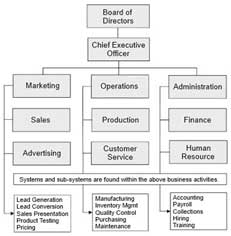Date. 1st November 2023
Bringing the organization Idea to prosperity
When you are establishing or making adjustments to the organization, you can make some choices about the kind of organization that you want to be a part of. Small organizations often start out with a fairly flat structure, owner and a few staff who all have direct access to the owner, but as the company grows, they also tend to become more hierarchical, employees reporting to a manager, who in turn reports to the owner. In large companies, there can be several layers of supervisors, managers, directors, and vice presidents.
As an owner, you may want to have contact with everyone, but the reality is that the bigger the company becomes, the more you will have to delegate and step back from the front line in order to manage your time and facilitate growth within the company.
In addition to giving, you a break from doing all the work yourself, introducing staff in senior or management roles allows you to establish paths of communication and authority or a chain of command in more formal organizations. For example, if you are getting ready to grow and you want to hire several people, but it is also time to file the company tax return, you will run yourself ragged with advertising vacancies, interviewing, hiring, checking references, and making job offers while combing through paperwork to get it to an accountant. Instead, you could delegate the hiring process to someone who specializes in human resources. Similarly, you can delegate financial reporting, day to day accounting, bank reconciliations, procurement, payroll, and tax remittance to an accountant. Ultimately, you will remain responsible for the outcomes that you get from human resources and finance, but you will do so by meeting with the people you assign those tasks.
When you start out, it may just be you and one other person. As the company grows, you run out of hours to get all the work done as well as doing the management tasks that are needed. Let’s say that you secure a big contract, and need to hire eight people to do the work, including an accountant and someone to do the hiring and people management.
Again, as the organization grows, we tend to add layers of management and workers to meet the business needs. Some companies will try to stay flat in order to provide those workers with the authority they need to carry on the work. At other times, they look like large, layered pyramids, like the one below. As the organization grows, people at the front line get farther away from the decision maker at the top of the pyramid, and the decision maker also gets farther away from the Organizational structure is of critical importance. If you are currently a small business that wants to grow, establishing the right structure will help you adapt to changes in the business environment. In addition, although we speak of structure, we have to keep in mind that the work is performed by and relationship developed with people. If you forget the human part of your business, you aren’t going to find much support for it.
The types of structures we have talked about so far are functional structures: the typical pyramid where the CEO is at the top and the functional positions report upward to the CEO. This, however, is not the only option.
In order to work within larger environments, particularly when you are working across time zones, borders, and among different cultures, it’s essential to be able to communicate throughout the organization. However, by implementing efficient organization structuresthat has strengths and weaknesses. You will need to weigh the options out and perhaps experiment in order to find what will work best for you.
A geographic structure, where there is a regional Vice President addressing the needs of each region, could be organized as follows. While this sometimes brings things closer together in terms of time zones, you’ll note that the cross-cultural mix will require attention to language, culture, and regional business practices.
In another example, where a multinational company needs to organize differently, they may implement a divisional structure, where people are organized according to their product. For example, a soap manufacturer and distributor are essential to customer in divisional and regional business practices.
Another format that is becoming more common in global companies is the matrix structure. The company is divided into horizontal and vertical silos according to geography and function, or sometimes products.
Matrix organizations have two or more management reporting structures. While this may seem confusing at first, team members typically have a primary manager for their department.
Reporting to a department manager functions similarly to a traditional work structure. For example, team members working in IT report to the IT department head. The IT department head reports to the vice president of their division. Eventually, all reporting relationships lead to the CEO.
The difference in a matrix structure is that team members also report to project managers. Projects often require work from members of various departments like IT, marketing, and finance, which is why having a separate manager for individual projects makes sense.
Organizational design involves implementing organizational structures and systems that align to an organization's core strategies. Often organization redesign happens because a business is growing or needs to downsize. However, it may also be because of a change in leadership, strategy, or due to changes in the organization's wider environment in which it operates.
When organizational design is effective it can have a number of benefits, includes the following.
Finally, each organization structure has benefits and some has weaknesses. At their best, people can develop and share what they learn through their scope of work through a best practice approach, creating a stronger and more viable organization. At their worst, infighting, negativepolitical environments,and internal competition can be extremely disruptive to the organization. Positive economic development in organization. Business leaders, including the Board Members, CEO, need to be very knowledgeable about every aspect of business administration and good leadership and management client, then having to do the work yourself.A well design organization structure will be asset to the business, increase efficient performance and obtained maximum market shares and profitability.



EMBA PGDCM PGDE PGCPM PDBS MQSi SACD
Building Scientist - Construction Economist
Quantity Surveyor - Valuer/ Appraiser
Construction & Project Management
Environmental Science & Natural Resource Management
37 Pattensen Turkeyen, Dennis Street, Georgetown, Guyana
Email: Jewelccameron55@yahoo.com